Leadership Practices and Challenges at Woolworths
VerifiedAdded on 2023/03/30
|12
|2908
|98
AI Summary
This report discusses the leadership practices and challenges faced by Woolworths, an Australian supermarket chain. It explores the concept of participative leadership and its strengths and weaknesses. The report also provides recommendations for performance improvement in Woolworths.
Contribute Materials
Your contribution can guide someone’s learning journey. Share your
documents today.
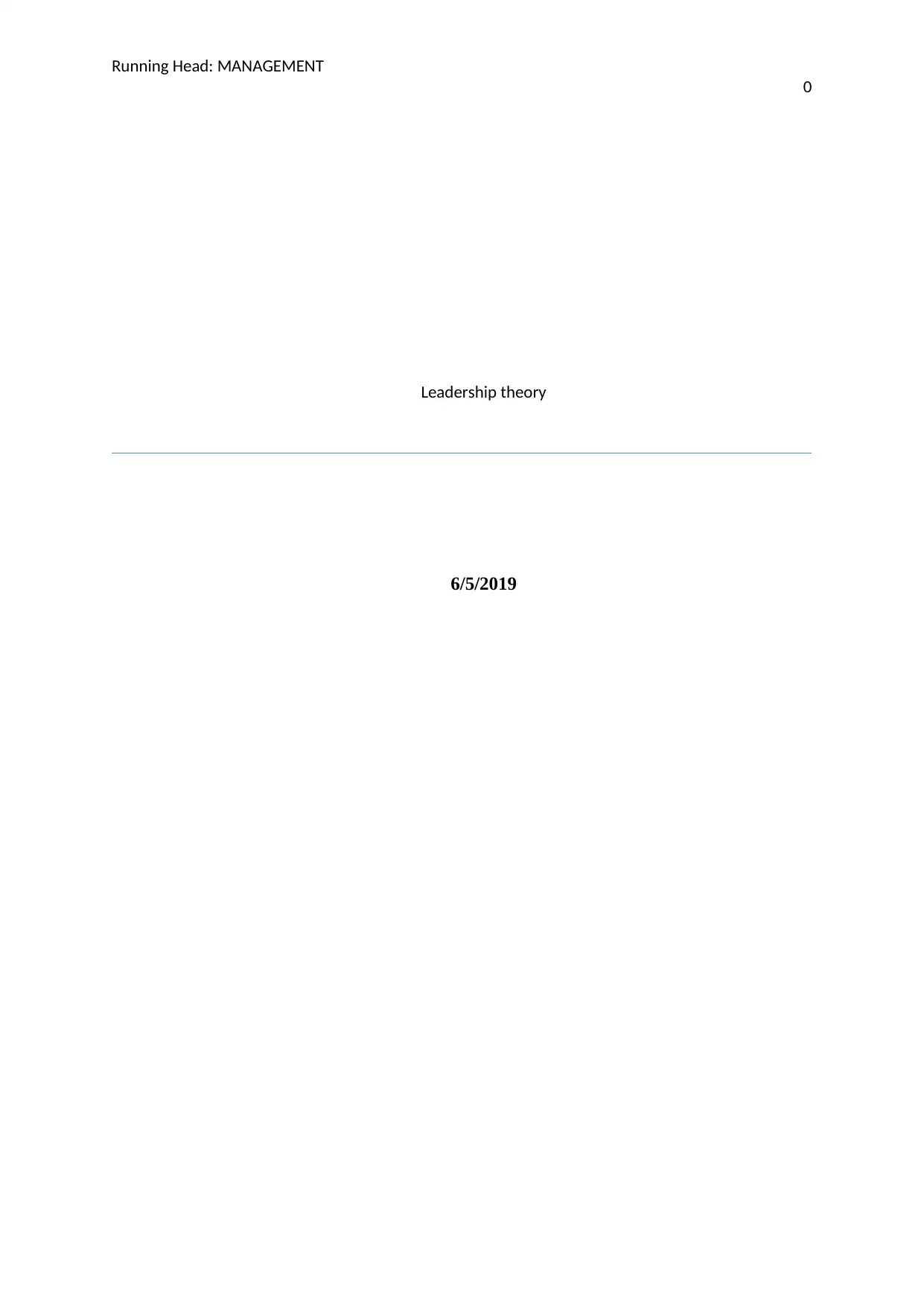
Running Head: MANAGEMENT
0
Leadership theory
6/5/2019
0
Leadership theory
6/5/2019
Secure Best Marks with AI Grader
Need help grading? Try our AI Grader for instant feedback on your assignments.

MANAGEMENT
1
Contents
Introduction...........................................................................................................................................2
Company Overview and Activities (Woolworths).................................................................................2
Leadership practices or style at Woolworths.........................................................................................3
Challenges or issues faced and leadership development programmes at Woolworths.......................3
Strengths and weakness of the Participative leadership.........................................................................4
Recommendations for performance improvement in Woolworths........................................................6
Conclusion.............................................................................................................................................8
1
Contents
Introduction...........................................................................................................................................2
Company Overview and Activities (Woolworths).................................................................................2
Leadership practices or style at Woolworths.........................................................................................3
Challenges or issues faced and leadership development programmes at Woolworths.......................3
Strengths and weakness of the Participative leadership.........................................................................4
Recommendations for performance improvement in Woolworths........................................................6
Conclusion.............................................................................................................................................8
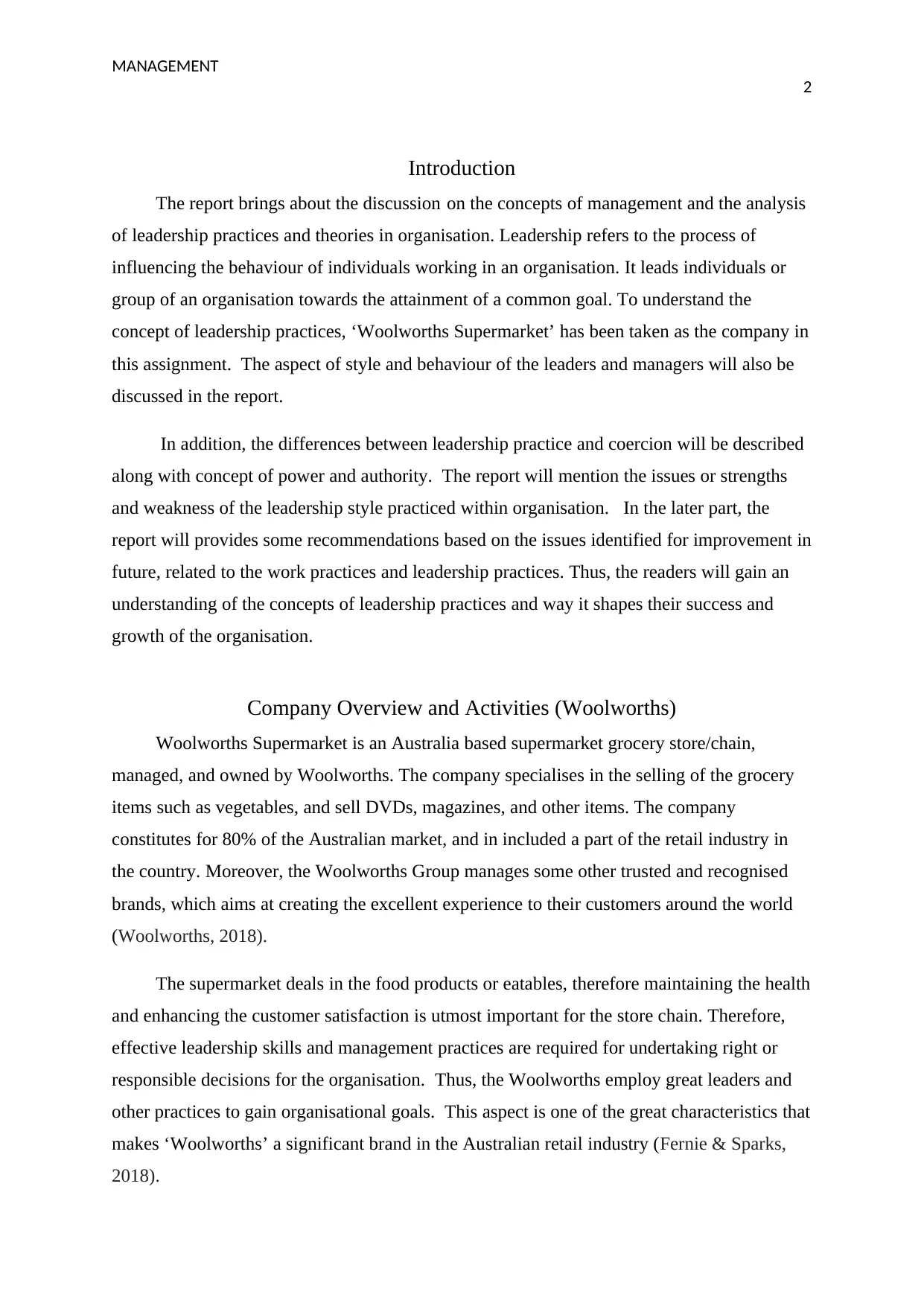
MANAGEMENT
2
Introduction
The report brings about the discussion on the concepts of management and the analysis
of leadership practices and theories in organisation. Leadership refers to the process of
influencing the behaviour of individuals working in an organisation. It leads individuals or
group of an organisation towards the attainment of a common goal. To understand the
concept of leadership practices, ‘Woolworths Supermarket’ has been taken as the company in
this assignment. The aspect of style and behaviour of the leaders and managers will also be
discussed in the report.
In addition, the differences between leadership practice and coercion will be described
along with concept of power and authority. The report will mention the issues or strengths
and weakness of the leadership style practiced within organisation. In the later part, the
report will provides some recommendations based on the issues identified for improvement in
future, related to the work practices and leadership practices. Thus, the readers will gain an
understanding of the concepts of leadership practices and way it shapes their success and
growth of the organisation.
Company Overview and Activities (Woolworths)
Woolworths Supermarket is an Australia based supermarket grocery store/chain,
managed, and owned by Woolworths. The company specialises in the selling of the grocery
items such as vegetables, and sell DVDs, magazines, and other items. The company
constitutes for 80% of the Australian market, and in included a part of the retail industry in
the country. Moreover, the Woolworths Group manages some other trusted and recognised
brands, which aims at creating the excellent experience to their customers around the world
(Woolworths, 2018).
The supermarket deals in the food products or eatables, therefore maintaining the health
and enhancing the customer satisfaction is utmost important for the store chain. Therefore,
effective leadership skills and management practices are required for undertaking right or
responsible decisions for the organisation. Thus, the Woolworths employ great leaders and
other practices to gain organisational goals. This aspect is one of the great characteristics that
makes ‘Woolworths’ a significant brand in the Australian retail industry (Fernie & Sparks,
2018).
2
Introduction
The report brings about the discussion on the concepts of management and the analysis
of leadership practices and theories in organisation. Leadership refers to the process of
influencing the behaviour of individuals working in an organisation. It leads individuals or
group of an organisation towards the attainment of a common goal. To understand the
concept of leadership practices, ‘Woolworths Supermarket’ has been taken as the company in
this assignment. The aspect of style and behaviour of the leaders and managers will also be
discussed in the report.
In addition, the differences between leadership practice and coercion will be described
along with concept of power and authority. The report will mention the issues or strengths
and weakness of the leadership style practiced within organisation. In the later part, the
report will provides some recommendations based on the issues identified for improvement in
future, related to the work practices and leadership practices. Thus, the readers will gain an
understanding of the concepts of leadership practices and way it shapes their success and
growth of the organisation.
Company Overview and Activities (Woolworths)
Woolworths Supermarket is an Australia based supermarket grocery store/chain,
managed, and owned by Woolworths. The company specialises in the selling of the grocery
items such as vegetables, and sell DVDs, magazines, and other items. The company
constitutes for 80% of the Australian market, and in included a part of the retail industry in
the country. Moreover, the Woolworths Group manages some other trusted and recognised
brands, which aims at creating the excellent experience to their customers around the world
(Woolworths, 2018).
The supermarket deals in the food products or eatables, therefore maintaining the health
and enhancing the customer satisfaction is utmost important for the store chain. Therefore,
effective leadership skills and management practices are required for undertaking right or
responsible decisions for the organisation. Thus, the Woolworths employ great leaders and
other practices to gain organisational goals. This aspect is one of the great characteristics that
makes ‘Woolworths’ a significant brand in the Australian retail industry (Fernie & Sparks,
2018).
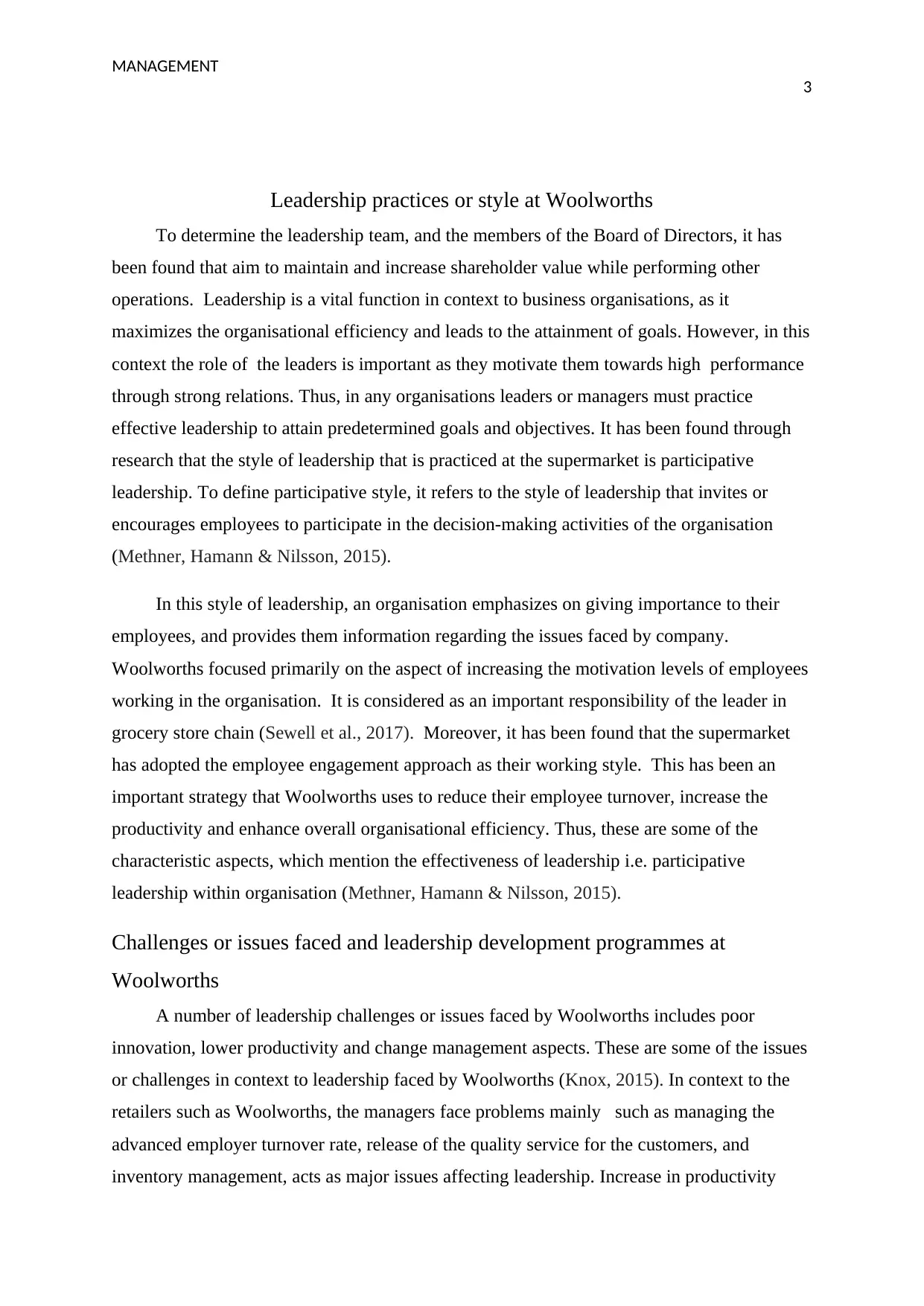
MANAGEMENT
3
Leadership practices or style at Woolworths
To determine the leadership team, and the members of the Board of Directors, it has
been found that aim to maintain and increase shareholder value while performing other
operations. Leadership is a vital function in context to business organisations, as it
maximizes the organisational efficiency and leads to the attainment of goals. However, in this
context the role of the leaders is important as they motivate them towards high performance
through strong relations. Thus, in any organisations leaders or managers must practice
effective leadership to attain predetermined goals and objectives. It has been found through
research that the style of leadership that is practiced at the supermarket is participative
leadership. To define participative style, it refers to the style of leadership that invites or
encourages employees to participate in the decision-making activities of the organisation
(Methner, Hamann & Nilsson, 2015).
In this style of leadership, an organisation emphasizes on giving importance to their
employees, and provides them information regarding the issues faced by company.
Woolworths focused primarily on the aspect of increasing the motivation levels of employees
working in the organisation. It is considered as an important responsibility of the leader in
grocery store chain (Sewell et al., 2017). Moreover, it has been found that the supermarket
has adopted the employee engagement approach as their working style. This has been an
important strategy that Woolworths uses to reduce their employee turnover, increase the
productivity and enhance overall organisational efficiency. Thus, these are some of the
characteristic aspects, which mention the effectiveness of leadership i.e. participative
leadership within organisation (Methner, Hamann & Nilsson, 2015).
Challenges or issues faced and leadership development programmes at
Woolworths
A number of leadership challenges or issues faced by Woolworths includes poor
innovation, lower productivity and change management aspects. These are some of the issues
or challenges in context to leadership faced by Woolworths (Knox, 2015). In context to the
retailers such as Woolworths, the managers face problems mainly such as managing the
advanced employer turnover rate, release of the quality service for the customers, and
inventory management, acts as major issues affecting leadership. Increase in productivity
3
Leadership practices or style at Woolworths
To determine the leadership team, and the members of the Board of Directors, it has
been found that aim to maintain and increase shareholder value while performing other
operations. Leadership is a vital function in context to business organisations, as it
maximizes the organisational efficiency and leads to the attainment of goals. However, in this
context the role of the leaders is important as they motivate them towards high performance
through strong relations. Thus, in any organisations leaders or managers must practice
effective leadership to attain predetermined goals and objectives. It has been found through
research that the style of leadership that is practiced at the supermarket is participative
leadership. To define participative style, it refers to the style of leadership that invites or
encourages employees to participate in the decision-making activities of the organisation
(Methner, Hamann & Nilsson, 2015).
In this style of leadership, an organisation emphasizes on giving importance to their
employees, and provides them information regarding the issues faced by company.
Woolworths focused primarily on the aspect of increasing the motivation levels of employees
working in the organisation. It is considered as an important responsibility of the leader in
grocery store chain (Sewell et al., 2017). Moreover, it has been found that the supermarket
has adopted the employee engagement approach as their working style. This has been an
important strategy that Woolworths uses to reduce their employee turnover, increase the
productivity and enhance overall organisational efficiency. Thus, these are some of the
characteristic aspects, which mention the effectiveness of leadership i.e. participative
leadership within organisation (Methner, Hamann & Nilsson, 2015).
Challenges or issues faced and leadership development programmes at
Woolworths
A number of leadership challenges or issues faced by Woolworths includes poor
innovation, lower productivity and change management aspects. These are some of the issues
or challenges in context to leadership faced by Woolworths (Knox, 2015). In context to the
retailers such as Woolworths, the managers face problems mainly such as managing the
advanced employer turnover rate, release of the quality service for the customers, and
inventory management, acts as major issues affecting leadership. Increase in productivity
Secure Best Marks with AI Grader
Need help grading? Try our AI Grader for instant feedback on your assignments.
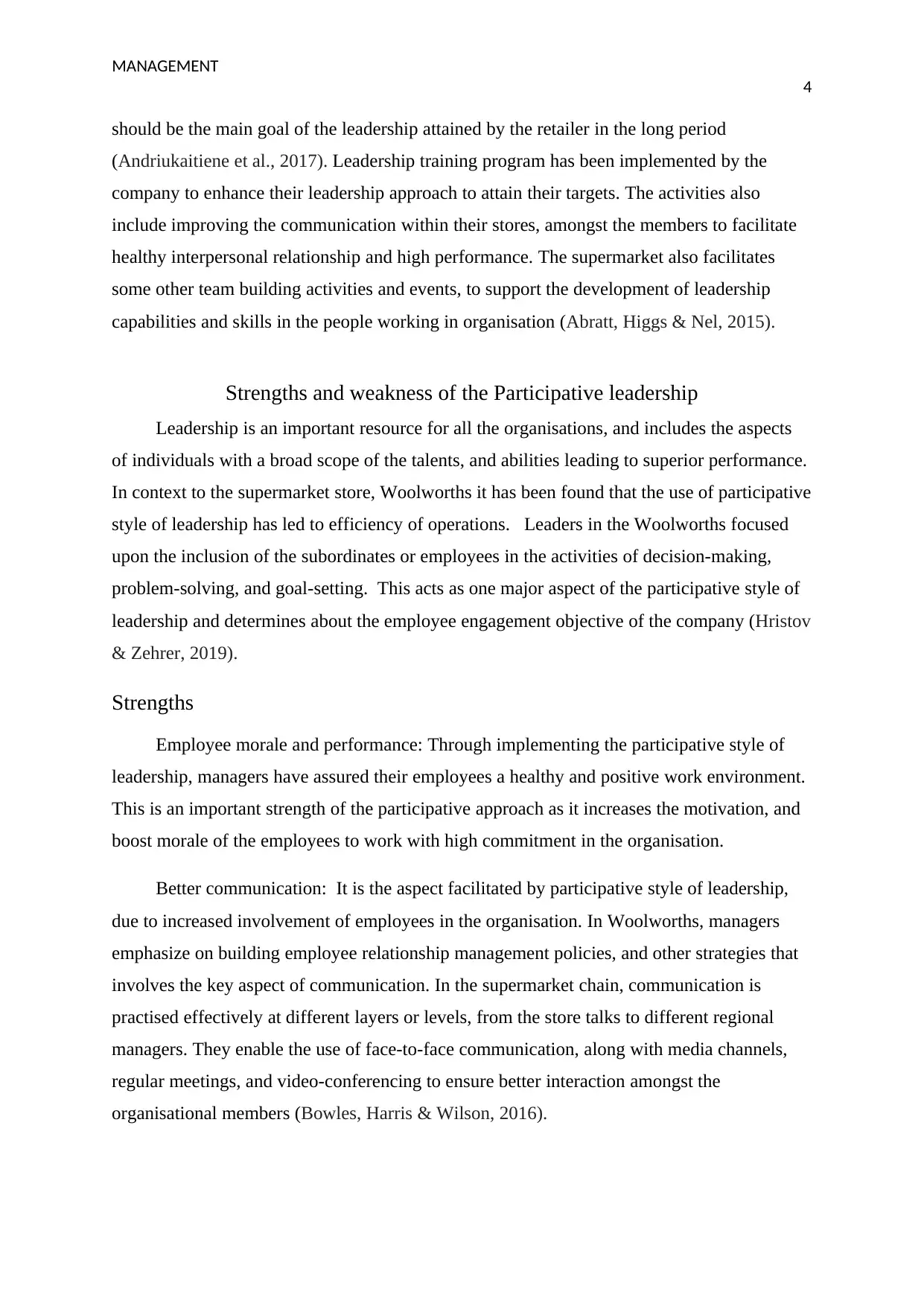
MANAGEMENT
4
should be the main goal of the leadership attained by the retailer in the long period
(Аndriukaitiene et al., 2017). Leadership training program has been implemented by the
company to enhance their leadership approach to attain their targets. The activities also
include improving the communication within their stores, amongst the members to facilitate
healthy interpersonal relationship and high performance. The supermarket also facilitates
some other team building activities and events, to support the development of leadership
capabilities and skills in the people working in organisation (Abratt, Higgs & Nel, 2015).
Strengths and weakness of the Participative leadership
Leadership is an important resource for all the organisations, and includes the aspects
of individuals with a broad scope of the talents, and abilities leading to superior performance.
In context to the supermarket store, Woolworths it has been found that the use of participative
style of leadership has led to efficiency of operations. Leaders in the Woolworths focused
upon the inclusion of the subordinates or employees in the activities of decision-making,
problem-solving, and goal-setting. This acts as one major aspect of the participative style of
leadership and determines about the employee engagement objective of the company (Hristov
& Zehrer, 2019).
Strengths
Employee morale and performance: Through implementing the participative style of
leadership, managers have assured their employees a healthy and positive work environment.
This is an important strength of the participative approach as it increases the motivation, and
boost morale of the employees to work with high commitment in the organisation.
Better communication: It is the aspect facilitated by participative style of leadership,
due to increased involvement of employees in the organisation. In Woolworths, managers
emphasize on building employee relationship management policies, and other strategies that
involves the key aspect of communication. In the supermarket chain, communication is
practised effectively at different layers or levels, from the store talks to different regional
managers. They enable the use of face-to-face communication, along with media channels,
regular meetings, and video-conferencing to ensure better interaction amongst the
organisational members (Bowles, Harris & Wilson, 2016).
4
should be the main goal of the leadership attained by the retailer in the long period
(Аndriukaitiene et al., 2017). Leadership training program has been implemented by the
company to enhance their leadership approach to attain their targets. The activities also
include improving the communication within their stores, amongst the members to facilitate
healthy interpersonal relationship and high performance. The supermarket also facilitates
some other team building activities and events, to support the development of leadership
capabilities and skills in the people working in organisation (Abratt, Higgs & Nel, 2015).
Strengths and weakness of the Participative leadership
Leadership is an important resource for all the organisations, and includes the aspects
of individuals with a broad scope of the talents, and abilities leading to superior performance.
In context to the supermarket store, Woolworths it has been found that the use of participative
style of leadership has led to efficiency of operations. Leaders in the Woolworths focused
upon the inclusion of the subordinates or employees in the activities of decision-making,
problem-solving, and goal-setting. This acts as one major aspect of the participative style of
leadership and determines about the employee engagement objective of the company (Hristov
& Zehrer, 2019).
Strengths
Employee morale and performance: Through implementing the participative style of
leadership, managers have assured their employees a healthy and positive work environment.
This is an important strength of the participative approach as it increases the motivation, and
boost morale of the employees to work with high commitment in the organisation.
Better communication: It is the aspect facilitated by participative style of leadership,
due to increased involvement of employees in the organisation. In Woolworths, managers
emphasize on building employee relationship management policies, and other strategies that
involves the key aspect of communication. In the supermarket chain, communication is
practised effectively at different layers or levels, from the store talks to different regional
managers. They enable the use of face-to-face communication, along with media channels,
regular meetings, and video-conferencing to ensure better interaction amongst the
organisational members (Bowles, Harris & Wilson, 2016).
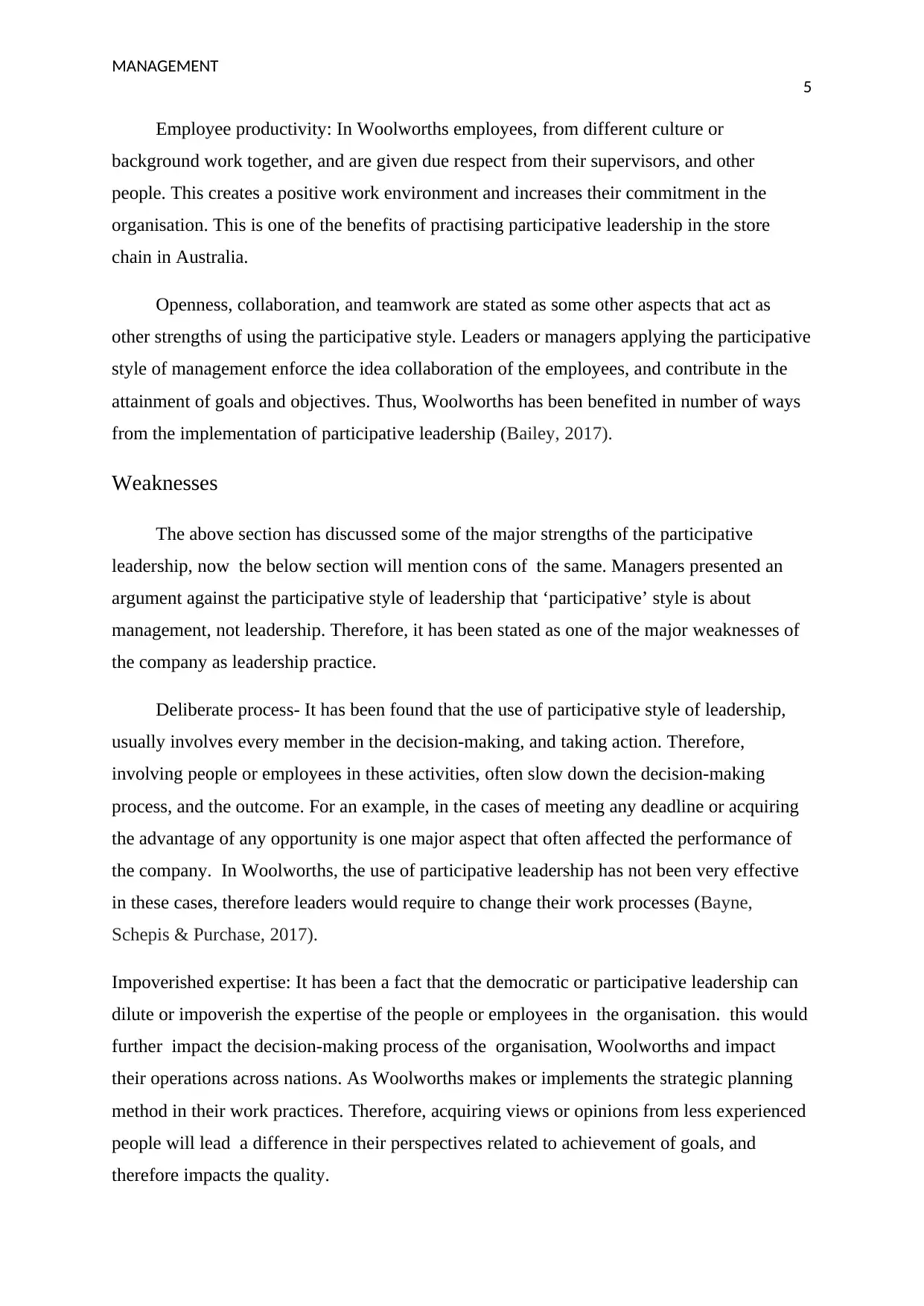
MANAGEMENT
5
Employee productivity: In Woolworths employees, from different culture or
background work together, and are given due respect from their supervisors, and other
people. This creates a positive work environment and increases their commitment in the
organisation. This is one of the benefits of practising participative leadership in the store
chain in Australia.
Openness, collaboration, and teamwork are stated as some other aspects that act as
other strengths of using the participative style. Leaders or managers applying the participative
style of management enforce the idea collaboration of the employees, and contribute in the
attainment of goals and objectives. Thus, Woolworths has been benefited in number of ways
from the implementation of participative leadership (Bailey, 2017).
Weaknesses
The above section has discussed some of the major strengths of the participative
leadership, now the below section will mention cons of the same. Managers presented an
argument against the participative style of leadership that ‘participative’ style is about
management, not leadership. Therefore, it has been stated as one of the major weaknesses of
the company as leadership practice.
Deliberate process- It has been found that the use of participative style of leadership,
usually involves every member in the decision-making, and taking action. Therefore,
involving people or employees in these activities, often slow down the decision-making
process, and the outcome. For an example, in the cases of meeting any deadline or acquiring
the advantage of any opportunity is one major aspect that often affected the performance of
the company. In Woolworths, the use of participative leadership has not been very effective
in these cases, therefore leaders would require to change their work processes (Bayne,
Schepis & Purchase, 2017).
Impoverished expertise: It has been a fact that the democratic or participative leadership can
dilute or impoverish the expertise of the people or employees in the organisation. this would
further impact the decision-making process of the organisation, Woolworths and impact
their operations across nations. As Woolworths makes or implements the strategic planning
method in their work practices. Therefore, acquiring views or opinions from less experienced
people will lead a difference in their perspectives related to achievement of goals, and
therefore impacts the quality.
5
Employee productivity: In Woolworths employees, from different culture or
background work together, and are given due respect from their supervisors, and other
people. This creates a positive work environment and increases their commitment in the
organisation. This is one of the benefits of practising participative leadership in the store
chain in Australia.
Openness, collaboration, and teamwork are stated as some other aspects that act as
other strengths of using the participative style. Leaders or managers applying the participative
style of management enforce the idea collaboration of the employees, and contribute in the
attainment of goals and objectives. Thus, Woolworths has been benefited in number of ways
from the implementation of participative leadership (Bailey, 2017).
Weaknesses
The above section has discussed some of the major strengths of the participative
leadership, now the below section will mention cons of the same. Managers presented an
argument against the participative style of leadership that ‘participative’ style is about
management, not leadership. Therefore, it has been stated as one of the major weaknesses of
the company as leadership practice.
Deliberate process- It has been found that the use of participative style of leadership,
usually involves every member in the decision-making, and taking action. Therefore,
involving people or employees in these activities, often slow down the decision-making
process, and the outcome. For an example, in the cases of meeting any deadline or acquiring
the advantage of any opportunity is one major aspect that often affected the performance of
the company. In Woolworths, the use of participative leadership has not been very effective
in these cases, therefore leaders would require to change their work processes (Bayne,
Schepis & Purchase, 2017).
Impoverished expertise: It has been a fact that the democratic or participative leadership can
dilute or impoverish the expertise of the people or employees in the organisation. this would
further impact the decision-making process of the organisation, Woolworths and impact
their operations across nations. As Woolworths makes or implements the strategic planning
method in their work practices. Therefore, acquiring views or opinions from less experienced
people will lead a difference in their perspectives related to achievement of goals, and
therefore impacts the quality.
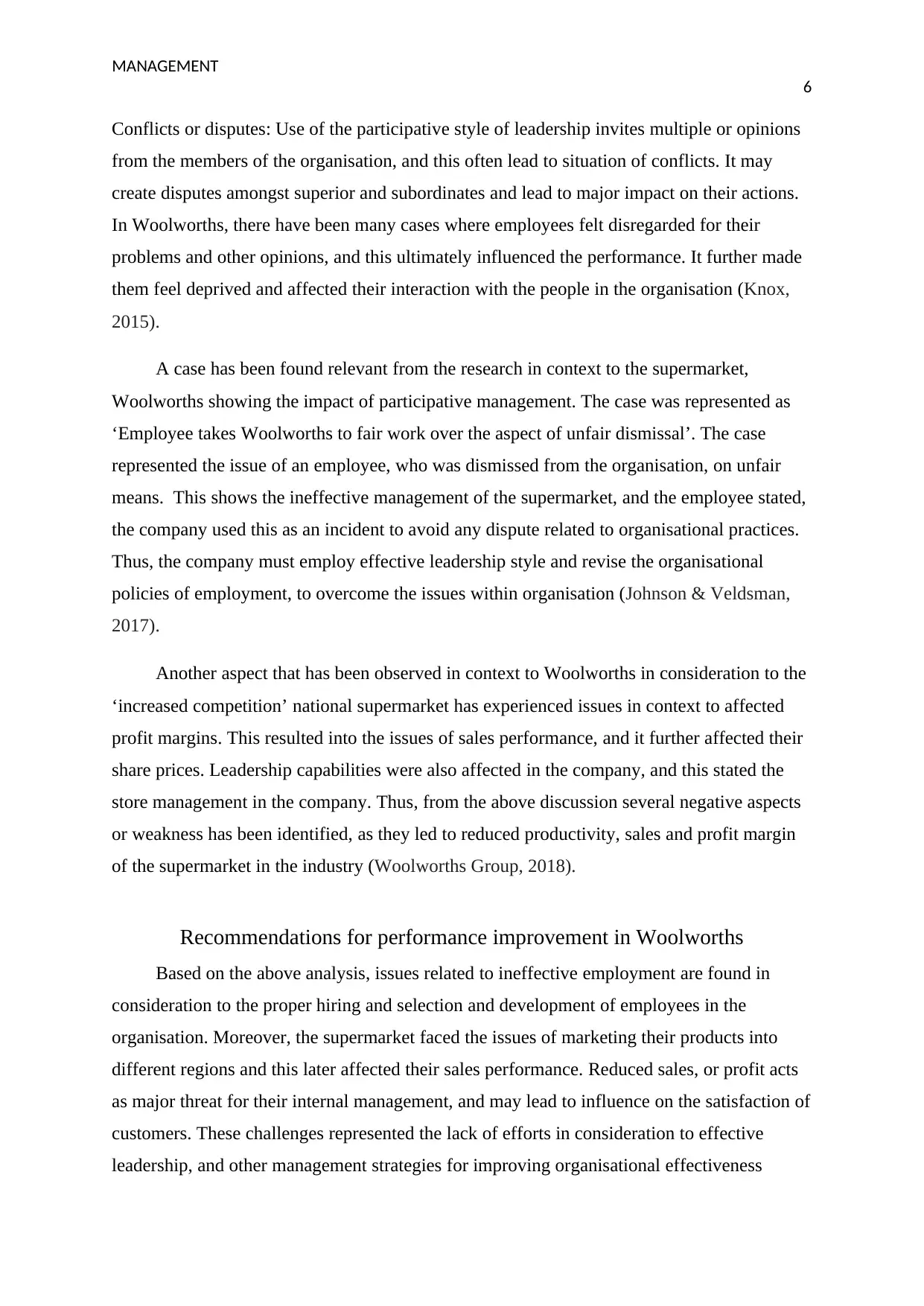
MANAGEMENT
6
Conflicts or disputes: Use of the participative style of leadership invites multiple or opinions
from the members of the organisation, and this often lead to situation of conflicts. It may
create disputes amongst superior and subordinates and lead to major impact on their actions.
In Woolworths, there have been many cases where employees felt disregarded for their
problems and other opinions, and this ultimately influenced the performance. It further made
them feel deprived and affected their interaction with the people in the organisation (Knox,
2015).
A case has been found relevant from the research in context to the supermarket,
Woolworths showing the impact of participative management. The case was represented as
‘Employee takes Woolworths to fair work over the aspect of unfair dismissal’. The case
represented the issue of an employee, who was dismissed from the organisation, on unfair
means. This shows the ineffective management of the supermarket, and the employee stated,
the company used this as an incident to avoid any dispute related to organisational practices.
Thus, the company must employ effective leadership style and revise the organisational
policies of employment, to overcome the issues within organisation (Johnson & Veldsman,
2017).
Another aspect that has been observed in context to Woolworths in consideration to the
‘increased competition’ national supermarket has experienced issues in context to affected
profit margins. This resulted into the issues of sales performance, and it further affected their
share prices. Leadership capabilities were also affected in the company, and this stated the
store management in the company. Thus, from the above discussion several negative aspects
or weakness has been identified, as they led to reduced productivity, sales and profit margin
of the supermarket in the industry (Woolworths Group, 2018).
Recommendations for performance improvement in Woolworths
Based on the above analysis, issues related to ineffective employment are found in
consideration to the proper hiring and selection and development of employees in the
organisation. Moreover, the supermarket faced the issues of marketing their products into
different regions and this later affected their sales performance. Reduced sales, or profit acts
as major threat for their internal management, and may lead to influence on the satisfaction of
customers. These challenges represented the lack of efforts in consideration to effective
leadership, and other management strategies for improving organisational effectiveness
6
Conflicts or disputes: Use of the participative style of leadership invites multiple or opinions
from the members of the organisation, and this often lead to situation of conflicts. It may
create disputes amongst superior and subordinates and lead to major impact on their actions.
In Woolworths, there have been many cases where employees felt disregarded for their
problems and other opinions, and this ultimately influenced the performance. It further made
them feel deprived and affected their interaction with the people in the organisation (Knox,
2015).
A case has been found relevant from the research in context to the supermarket,
Woolworths showing the impact of participative management. The case was represented as
‘Employee takes Woolworths to fair work over the aspect of unfair dismissal’. The case
represented the issue of an employee, who was dismissed from the organisation, on unfair
means. This shows the ineffective management of the supermarket, and the employee stated,
the company used this as an incident to avoid any dispute related to organisational practices.
Thus, the company must employ effective leadership style and revise the organisational
policies of employment, to overcome the issues within organisation (Johnson & Veldsman,
2017).
Another aspect that has been observed in context to Woolworths in consideration to the
‘increased competition’ national supermarket has experienced issues in context to affected
profit margins. This resulted into the issues of sales performance, and it further affected their
share prices. Leadership capabilities were also affected in the company, and this stated the
store management in the company. Thus, from the above discussion several negative aspects
or weakness has been identified, as they led to reduced productivity, sales and profit margin
of the supermarket in the industry (Woolworths Group, 2018).
Recommendations for performance improvement in Woolworths
Based on the above analysis, issues related to ineffective employment are found in
consideration to the proper hiring and selection and development of employees in the
organisation. Moreover, the supermarket faced the issues of marketing their products into
different regions and this later affected their sales performance. Reduced sales, or profit acts
as major threat for their internal management, and may lead to influence on the satisfaction of
customers. These challenges represented the lack of efforts in consideration to effective
leadership, and other management strategies for improving organisational effectiveness
Paraphrase This Document
Need a fresh take? Get an instant paraphrase of this document with our AI Paraphraser
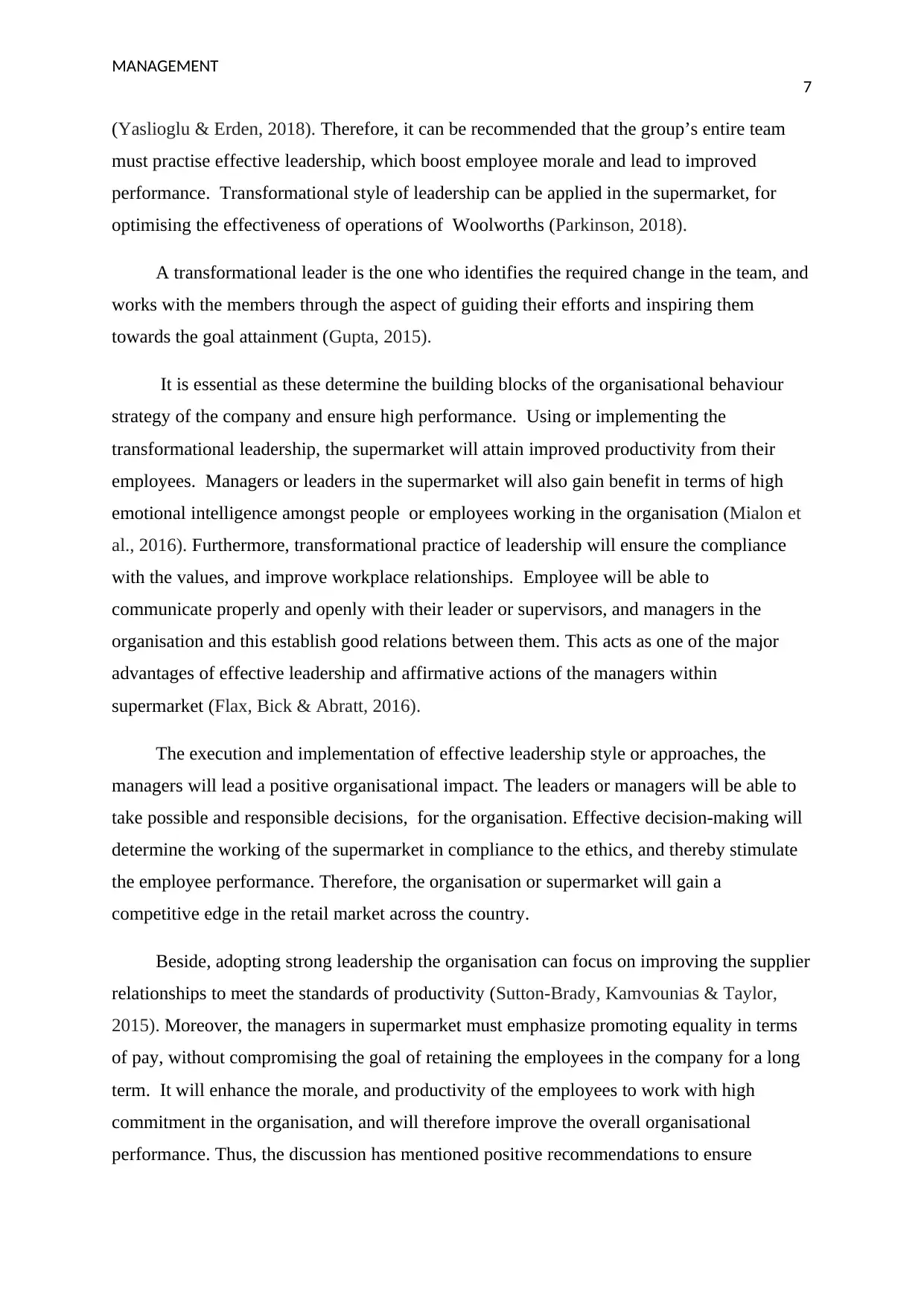
MANAGEMENT
7
(Yaslioglu & Erden, 2018). Therefore, it can be recommended that the group’s entire team
must practise effective leadership, which boost employee morale and lead to improved
performance. Transformational style of leadership can be applied in the supermarket, for
optimising the effectiveness of operations of Woolworths (Parkinson, 2018).
A transformational leader is the one who identifies the required change in the team, and
works with the members through the aspect of guiding their efforts and inspiring them
towards the goal attainment (Gupta, 2015).
It is essential as these determine the building blocks of the organisational behaviour
strategy of the company and ensure high performance. Using or implementing the
transformational leadership, the supermarket will attain improved productivity from their
employees. Managers or leaders in the supermarket will also gain benefit in terms of high
emotional intelligence amongst people or employees working in the organisation (Mialon et
al., 2016). Furthermore, transformational practice of leadership will ensure the compliance
with the values, and improve workplace relationships. Employee will be able to
communicate properly and openly with their leader or supervisors, and managers in the
organisation and this establish good relations between them. This acts as one of the major
advantages of effective leadership and affirmative actions of the managers within
supermarket (Flax, Bick & Abratt, 2016).
The execution and implementation of effective leadership style or approaches, the
managers will lead a positive organisational impact. The leaders or managers will be able to
take possible and responsible decisions, for the organisation. Effective decision-making will
determine the working of the supermarket in compliance to the ethics, and thereby stimulate
the employee performance. Therefore, the organisation or supermarket will gain a
competitive edge in the retail market across the country.
Beside, adopting strong leadership the organisation can focus on improving the supplier
relationships to meet the standards of productivity (Sutton-Brady, Kamvounias & Taylor,
2015). Moreover, the managers in supermarket must emphasize promoting equality in terms
of pay, without compromising the goal of retaining the employees in the company for a long
term. It will enhance the morale, and productivity of the employees to work with high
commitment in the organisation, and will therefore improve the overall organisational
performance. Thus, the discussion has mentioned positive recommendations to ensure
7
(Yaslioglu & Erden, 2018). Therefore, it can be recommended that the group’s entire team
must practise effective leadership, which boost employee morale and lead to improved
performance. Transformational style of leadership can be applied in the supermarket, for
optimising the effectiveness of operations of Woolworths (Parkinson, 2018).
A transformational leader is the one who identifies the required change in the team, and
works with the members through the aspect of guiding their efforts and inspiring them
towards the goal attainment (Gupta, 2015).
It is essential as these determine the building blocks of the organisational behaviour
strategy of the company and ensure high performance. Using or implementing the
transformational leadership, the supermarket will attain improved productivity from their
employees. Managers or leaders in the supermarket will also gain benefit in terms of high
emotional intelligence amongst people or employees working in the organisation (Mialon et
al., 2016). Furthermore, transformational practice of leadership will ensure the compliance
with the values, and improve workplace relationships. Employee will be able to
communicate properly and openly with their leader or supervisors, and managers in the
organisation and this establish good relations between them. This acts as one of the major
advantages of effective leadership and affirmative actions of the managers within
supermarket (Flax, Bick & Abratt, 2016).
The execution and implementation of effective leadership style or approaches, the
managers will lead a positive organisational impact. The leaders or managers will be able to
take possible and responsible decisions, for the organisation. Effective decision-making will
determine the working of the supermarket in compliance to the ethics, and thereby stimulate
the employee performance. Therefore, the organisation or supermarket will gain a
competitive edge in the retail market across the country.
Beside, adopting strong leadership the organisation can focus on improving the supplier
relationships to meet the standards of productivity (Sutton-Brady, Kamvounias & Taylor,
2015). Moreover, the managers in supermarket must emphasize promoting equality in terms
of pay, without compromising the goal of retaining the employees in the company for a long
term. It will enhance the morale, and productivity of the employees to work with high
commitment in the organisation, and will therefore improve the overall organisational
performance. Thus, the discussion has mentioned positive recommendations to ensure
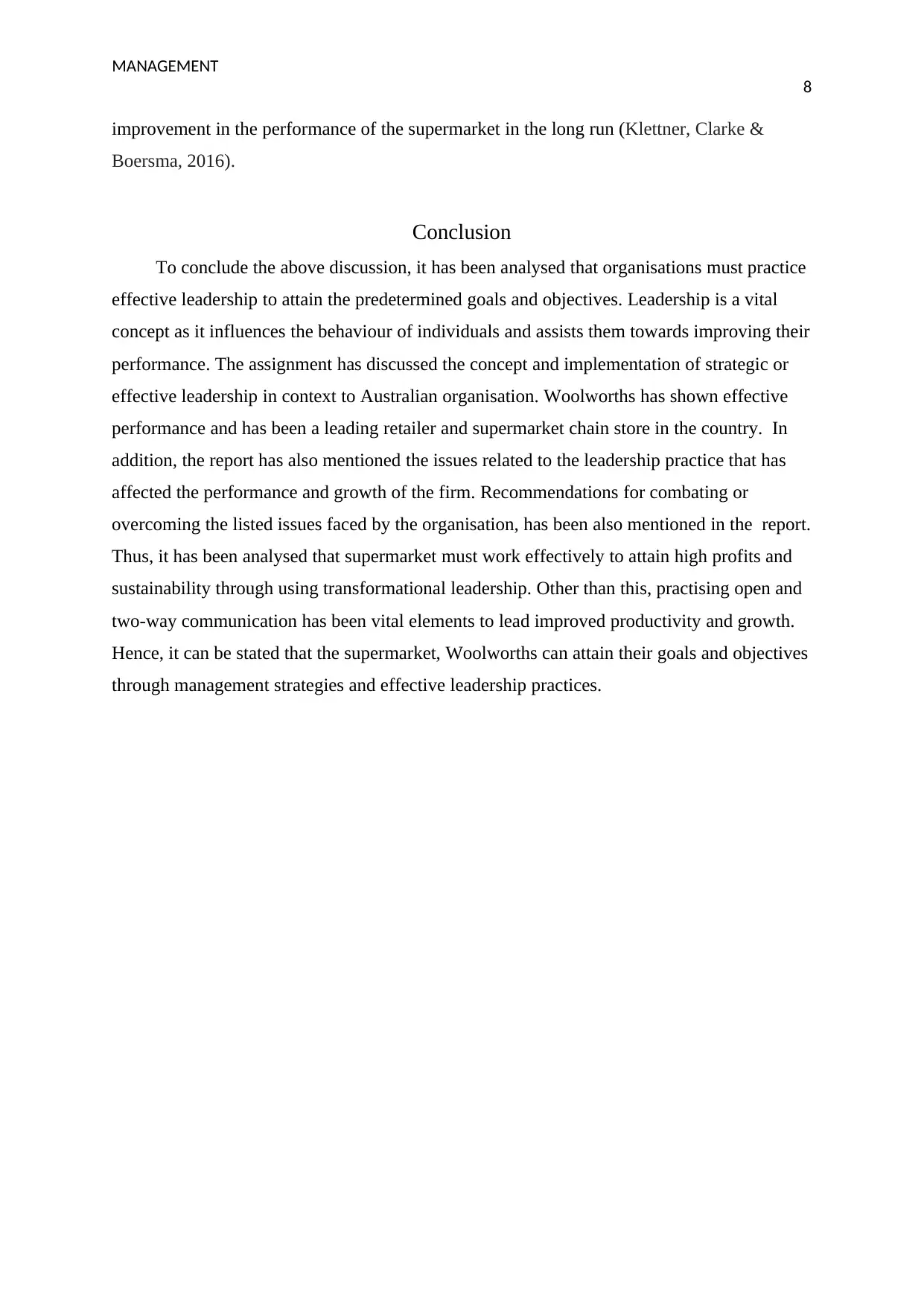
MANAGEMENT
8
improvement in the performance of the supermarket in the long run (Klettner, Clarke &
Boersma, 2016).
Conclusion
To conclude the above discussion, it has been analysed that organisations must practice
effective leadership to attain the predetermined goals and objectives. Leadership is a vital
concept as it influences the behaviour of individuals and assists them towards improving their
performance. The assignment has discussed the concept and implementation of strategic or
effective leadership in context to Australian organisation. Woolworths has shown effective
performance and has been a leading retailer and supermarket chain store in the country. In
addition, the report has also mentioned the issues related to the leadership practice that has
affected the performance and growth of the firm. Recommendations for combating or
overcoming the listed issues faced by the organisation, has been also mentioned in the report.
Thus, it has been analysed that supermarket must work effectively to attain high profits and
sustainability through using transformational leadership. Other than this, practising open and
two-way communication has been vital elements to lead improved productivity and growth.
Hence, it can be stated that the supermarket, Woolworths can attain their goals and objectives
through management strategies and effective leadership practices.
8
improvement in the performance of the supermarket in the long run (Klettner, Clarke &
Boersma, 2016).
Conclusion
To conclude the above discussion, it has been analysed that organisations must practice
effective leadership to attain the predetermined goals and objectives. Leadership is a vital
concept as it influences the behaviour of individuals and assists them towards improving their
performance. The assignment has discussed the concept and implementation of strategic or
effective leadership in context to Australian organisation. Woolworths has shown effective
performance and has been a leading retailer and supermarket chain store in the country. In
addition, the report has also mentioned the issues related to the leadership practice that has
affected the performance and growth of the firm. Recommendations for combating or
overcoming the listed issues faced by the organisation, has been also mentioned in the report.
Thus, it has been analysed that supermarket must work effectively to attain high profits and
sustainability through using transformational leadership. Other than this, practising open and
two-way communication has been vital elements to lead improved productivity and growth.
Hence, it can be stated that the supermarket, Woolworths can attain their goals and objectives
through management strategies and effective leadership practices.
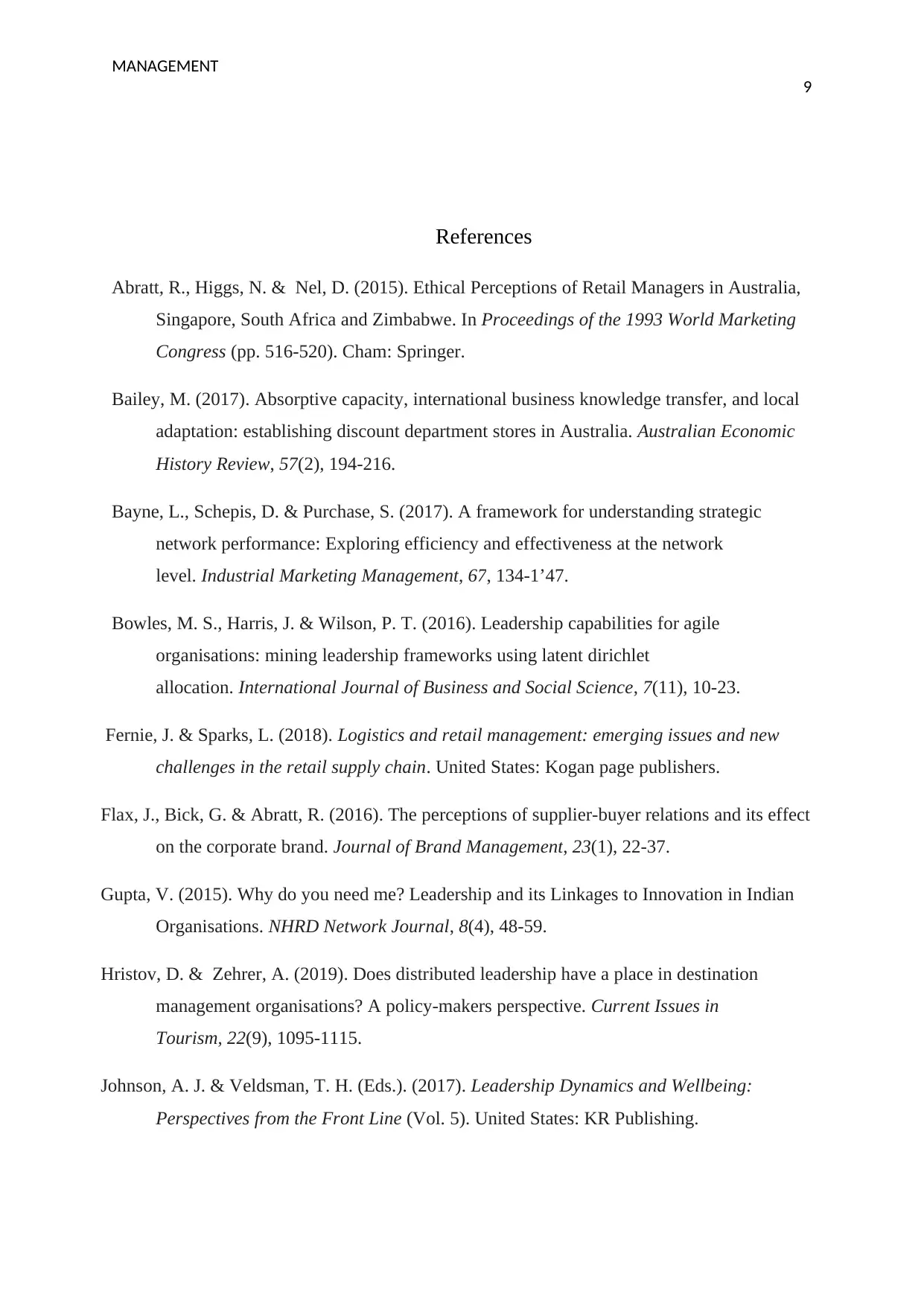
MANAGEMENT
9
References
Abratt, R., Higgs, N. & Nel, D. (2015). Ethical Perceptions of Retail Managers in Australia,
Singapore, South Africa and Zimbabwe. In Proceedings of the 1993 World Marketing
Congress (pp. 516-520). Cham: Springer.
Bailey, M. (2017). Absorptive capacity, international business knowledge transfer, and local
adaptation: establishing discount department stores in Australia. Australian Economic
History Review, 57(2), 194-216.
Bayne, L., Schepis, D. & Purchase, S. (2017). A framework for understanding strategic
network performance: Exploring efficiency and effectiveness at the network
level. Industrial Marketing Management, 67, 134-1’47.
Bowles, M. S., Harris, J. & Wilson, P. T. (2016). Leadership capabilities for agile
organisations: mining leadership frameworks using latent dirichlet
allocation. International Journal of Business and Social Science, 7(11), 10-23.
Fernie, J. & Sparks, L. (2018). Logistics and retail management: emerging issues and new
challenges in the retail supply chain. United States: Kogan page publishers.
Flax, J., Bick, G. & Abratt, R. (2016). The perceptions of supplier-buyer relations and its effect
on the corporate brand. Journal of Brand Management, 23(1), 22-37.
Gupta, V. (2015). Why do you need me? Leadership and its Linkages to Innovation in Indian
Organisations. NHRD Network Journal, 8(4), 48-59.
Hristov, D. & Zehrer, A. (2019). Does distributed leadership have a place in destination
management organisations? A policy-makers perspective. Current Issues in
Tourism, 22(9), 1095-1115.
Johnson, A. J. & Veldsman, T. H. (Eds.). (2017). Leadership Dynamics and Wellbeing:
Perspectives from the Front Line (Vol. 5). United States: KR Publishing.
9
References
Abratt, R., Higgs, N. & Nel, D. (2015). Ethical Perceptions of Retail Managers in Australia,
Singapore, South Africa and Zimbabwe. In Proceedings of the 1993 World Marketing
Congress (pp. 516-520). Cham: Springer.
Bailey, M. (2017). Absorptive capacity, international business knowledge transfer, and local
adaptation: establishing discount department stores in Australia. Australian Economic
History Review, 57(2), 194-216.
Bayne, L., Schepis, D. & Purchase, S. (2017). A framework for understanding strategic
network performance: Exploring efficiency and effectiveness at the network
level. Industrial Marketing Management, 67, 134-1’47.
Bowles, M. S., Harris, J. & Wilson, P. T. (2016). Leadership capabilities for agile
organisations: mining leadership frameworks using latent dirichlet
allocation. International Journal of Business and Social Science, 7(11), 10-23.
Fernie, J. & Sparks, L. (2018). Logistics and retail management: emerging issues and new
challenges in the retail supply chain. United States: Kogan page publishers.
Flax, J., Bick, G. & Abratt, R. (2016). The perceptions of supplier-buyer relations and its effect
on the corporate brand. Journal of Brand Management, 23(1), 22-37.
Gupta, V. (2015). Why do you need me? Leadership and its Linkages to Innovation in Indian
Organisations. NHRD Network Journal, 8(4), 48-59.
Hristov, D. & Zehrer, A. (2019). Does distributed leadership have a place in destination
management organisations? A policy-makers perspective. Current Issues in
Tourism, 22(9), 1095-1115.
Johnson, A. J. & Veldsman, T. H. (Eds.). (2017). Leadership Dynamics and Wellbeing:
Perspectives from the Front Line (Vol. 5). United States: KR Publishing.
Secure Best Marks with AI Grader
Need help grading? Try our AI Grader for instant feedback on your assignments.
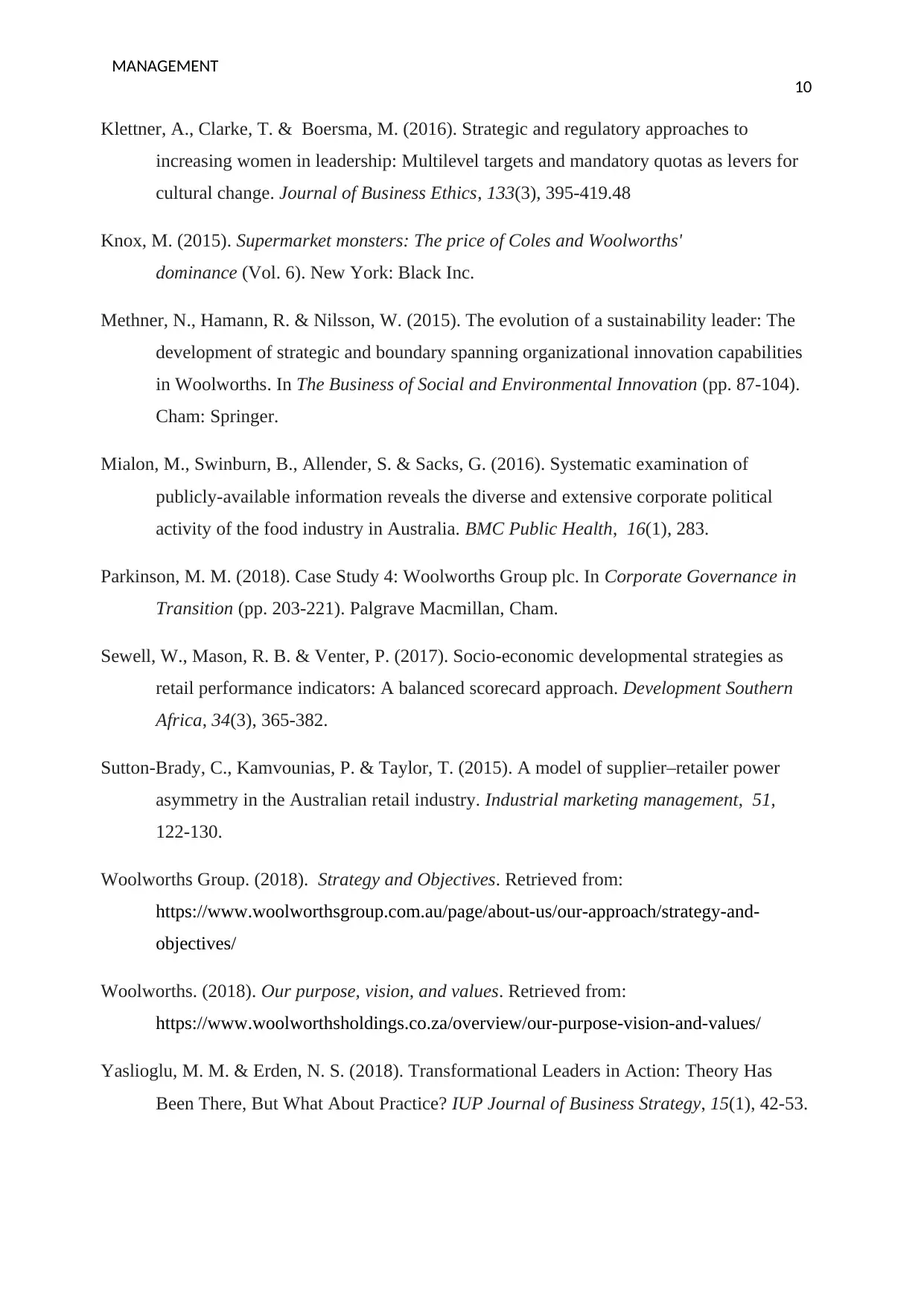
MANAGEMENT
10
Klettner, A., Clarke, T. & Boersma, M. (2016). Strategic and regulatory approaches to
increasing women in leadership: Multilevel targets and mandatory quotas as levers for
cultural change. Journal of Business Ethics, 133(3), 395-419.48
Knox, M. (2015). Supermarket monsters: The price of Coles and Woolworths'
dominance (Vol. 6). New York: Black Inc.
Methner, N., Hamann, R. & Nilsson, W. (2015). The evolution of a sustainability leader: The
development of strategic and boundary spanning organizational innovation capabilities
in Woolworths. In The Business of Social and Environmental Innovation (pp. 87-104).
Cham: Springer.
Mialon, M., Swinburn, B., Allender, S. & Sacks, G. (2016). Systematic examination of
publicly-available information reveals the diverse and extensive corporate political
activity of the food industry in Australia. BMC Public Health, 16(1), 283.
Parkinson, M. M. (2018). Case Study 4: Woolworths Group plc. In Corporate Governance in
Transition (pp. 203-221). Palgrave Macmillan, Cham.
Sewell, W., Mason, R. B. & Venter, P. (2017). Socio-economic developmental strategies as
retail performance indicators: A balanced scorecard approach. Development Southern
Africa, 34(3), 365-382.
Sutton-Brady, C., Kamvounias, P. & Taylor, T. (2015). A model of supplier–retailer power
asymmetry in the Australian retail industry. Industrial marketing management, 51,
122-130.
Woolworths Group. (2018). Strategy and Objectives. Retrieved from:
https://www.woolworthsgroup.com.au/page/about-us/our-approach/strategy-and-
objectives/
Woolworths. (2018). Our purpose, vision, and values. Retrieved from:
https://www.woolworthsholdings.co.za/overview/our-purpose-vision-and-values/
Yaslioglu, M. M. & Erden, N. S. (2018). Transformational Leaders in Action: Theory Has
Been There, But What About Practice? IUP Journal of Business Strategy, 15(1), 42-53.
10
Klettner, A., Clarke, T. & Boersma, M. (2016). Strategic and regulatory approaches to
increasing women in leadership: Multilevel targets and mandatory quotas as levers for
cultural change. Journal of Business Ethics, 133(3), 395-419.48
Knox, M. (2015). Supermarket monsters: The price of Coles and Woolworths'
dominance (Vol. 6). New York: Black Inc.
Methner, N., Hamann, R. & Nilsson, W. (2015). The evolution of a sustainability leader: The
development of strategic and boundary spanning organizational innovation capabilities
in Woolworths. In The Business of Social and Environmental Innovation (pp. 87-104).
Cham: Springer.
Mialon, M., Swinburn, B., Allender, S. & Sacks, G. (2016). Systematic examination of
publicly-available information reveals the diverse and extensive corporate political
activity of the food industry in Australia. BMC Public Health, 16(1), 283.
Parkinson, M. M. (2018). Case Study 4: Woolworths Group plc. In Corporate Governance in
Transition (pp. 203-221). Palgrave Macmillan, Cham.
Sewell, W., Mason, R. B. & Venter, P. (2017). Socio-economic developmental strategies as
retail performance indicators: A balanced scorecard approach. Development Southern
Africa, 34(3), 365-382.
Sutton-Brady, C., Kamvounias, P. & Taylor, T. (2015). A model of supplier–retailer power
asymmetry in the Australian retail industry. Industrial marketing management, 51,
122-130.
Woolworths Group. (2018). Strategy and Objectives. Retrieved from:
https://www.woolworthsgroup.com.au/page/about-us/our-approach/strategy-and-
objectives/
Woolworths. (2018). Our purpose, vision, and values. Retrieved from:
https://www.woolworthsholdings.co.za/overview/our-purpose-vision-and-values/
Yaslioglu, M. M. & Erden, N. S. (2018). Transformational Leaders in Action: Theory Has
Been There, But What About Practice? IUP Journal of Business Strategy, 15(1), 42-53.
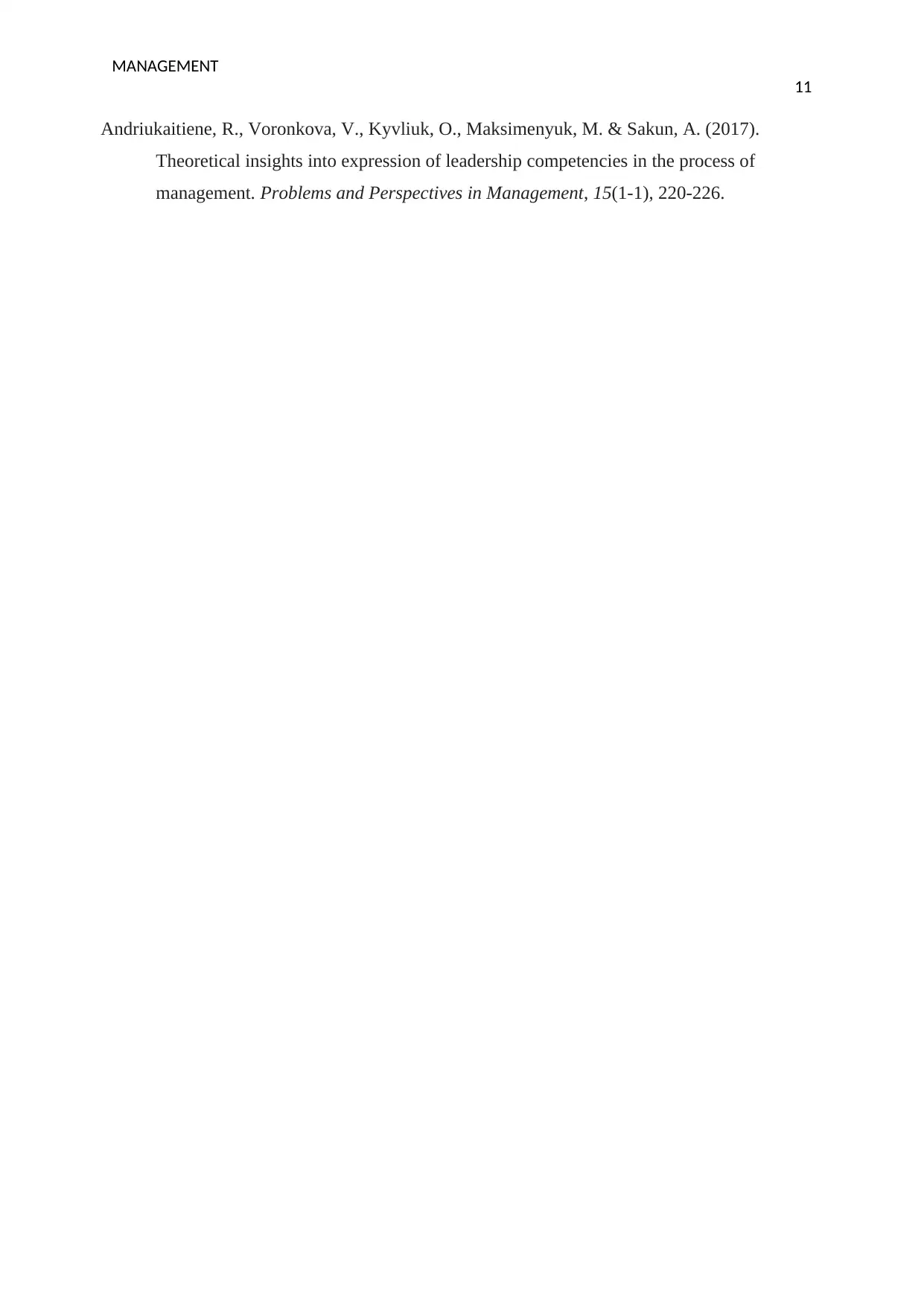
MANAGEMENT
11
Аndriukaitiene, R., Voronkova, V., Kyvliuk, O., Maksimenyuk, M. & Sakun, A. (2017).
Theoretical insights into expression of leadership competencies in the process of
management. Problems and Perspectives in Management, 15(1-1), 220-226.
11
Аndriukaitiene, R., Voronkova, V., Kyvliuk, O., Maksimenyuk, M. & Sakun, A. (2017).
Theoretical insights into expression of leadership competencies in the process of
management. Problems and Perspectives in Management, 15(1-1), 220-226.
1 out of 12
Related Documents
Your All-in-One AI-Powered Toolkit for Academic Success.
+13062052269
info@desklib.com
Available 24*7 on WhatsApp / Email
![[object Object]](/_next/static/media/star-bottom.7253800d.svg)
Unlock your academic potential
© 2024 | Zucol Services PVT LTD | All rights reserved.




